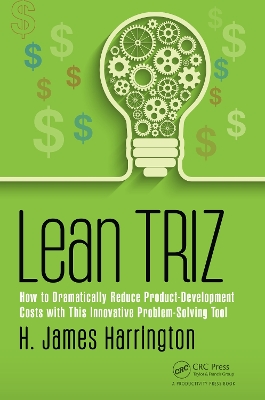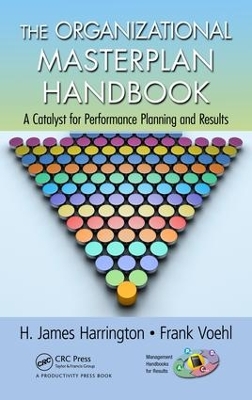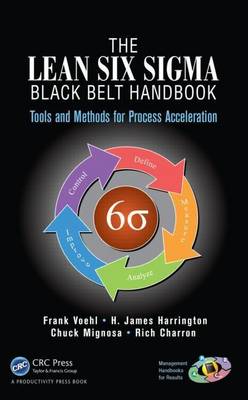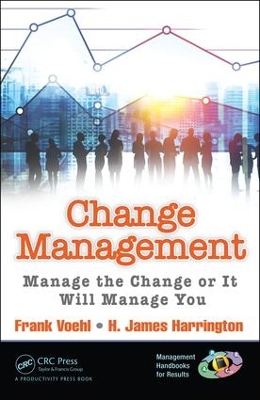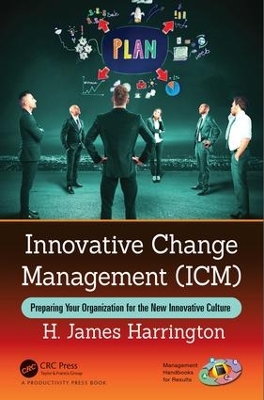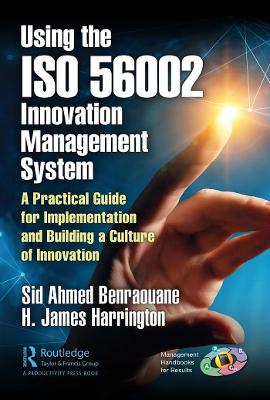Management Handbooks for Results
10 total works
Lean TRIZ is a new workshop-based process that brings together teams to focus on specific processes, evolutionary product designs, and improvement opportunities. It combines the insight of TRIZ with the simplicity of Value Engineering, EXPRESS, or FAST methodologies. TRIZ is the most advanced problem solving tool available. By combining TRIZ’s simplest concepts with those in the EXPRESS methodology (used by Ford and Ernst & Young), it is feasible to apply this new methodology to new concepts that are not traditionally applicable to the TRIZ methodology. This combination is guaranteed to greatly improve the quality and breakthrough results of a team that works on the problem within two days.
The Organizational Master Plan Handbook
by H James Harrington and Frank Voehl
The Framework for Innovation
by Frank Voehl, H James Harrington, Rick Fernandez, and Brett Trusko
The innovation infrastructure and master plan described in this book offers a detailed and comprehensive approach to one of the most difficult and challenging problems facing entrepreneurs involved in innovation at any scale enterprise: the problem of how to govern your organization’s innovation initiatives in the middle of turbulent change. Progress in any field requires the development of a framework, a structure that organizes the accumulating knowledge, enables people to master it, and unifies the key discoveries into a set of principles that
makes them understandable and actionable.
For starters, successful innovation requires an integrated design process, beginning with integration in the design of the enterprise, the design of the product, along with the design and implementation of new technologies. Such an integrated design effort requires good collaboration and management of the design framework, and should be supported by efficient knowledge management techniques and tools; If innovation is to help a business grow and improve its competitiveness, it is also important to plan the innovation carefully.
This book provides a holistic, multidisciplinary framework that will enable your organization and its leaders to take a strategic approach to innovation. The framework combines non-traditional,
creative approaches to business innovation with conventional strategy development models. The framework model brings together perspectives from many complementary disciplines: the non-traditional approaches to innovation found in the business creativity movement; multiple-source strategy consulting; the new product development perspective of many leading industrial design firms; qualitative consumer/customer research; future-based research found in think tanks and traditional scenario planning; and organizational development (OD) practices that examine the effectiveness of an organization’s culture, processes, and structure.
Though some ideas may just "fall from the sky" or "come out of the blue", an organization should also have a strategic vision of how the business and the enterprise will successfully develop. It should not just wait for the innovation to arrive arbitrarily, but rather proactively plan for innovation incorporating market trends, the competitive landscape, new technology availability, and changes in customer preferences and trends in order to create a flexible in-house innovation process. Such an enterprise will also pro-actively manage the knowledge supply chain that supports innovation, as outlined in this book #7 of Management Handbook for Results series.
The framework outlined in this handbook consists of a well-integrated cohesive set of practices that inspires imaginative innovation teams to look beyond the obvious and explore a broad range of possibilities to identify significant opportunities and make informed decisions about the most promising paths to pursue. The goal is to create a shared vision for growth, along with defining pragmatic action plans that bridge from the future back to the present, while attempting to align the organization around the requirements for success.
Lean Six SIGMA Black Belt Handbook
by Frank Voehl, H James Harrington, and Chuck Mignosa
Lean Management Systems Handbook
by Rich Charron, H James Harrington, and Frank Voehl
Change Management: Manage Change or It Will Manage You represents a substantial core guidance effort for Change Management practitioners. Organizations currently contend with increasingly higher levels of knowledge-driven competition. Many attempt to meet the challenge by investing in expensive knowledge-driven change management systems. Such systems are useless, and sometimes even harmful, for making strategic decisions because they do not distinguish between what is strategically relevant and what is not.
This Management-for-Results Handbook focuses on identifying and managing the specific, critical knowledge assets that your organization needs to disrupt your competitors, including tacit experience of key employees, a deep understanding of customers’ needs, valuable patents and copyrights, shared industry practices, and customer- and supplier-generated innovations. The authors present two aspects of Change Management: (1) traditional Change Management as it impacts the project management team’s activities and (2) a suggested new approach to Change Management directed at changing the culture. The focus is to prepare the people impacted by the project and change activities to accept and adapt to the new/changed working conditions.
The first half of the book deals with traditional Change Management, which covers the topics of remembering, understanding, and applying. The second half presents the authors’ new approach to changing the culture, which deals with analyzing, evaluating, and creating.
The Organizational Alignment Handbook
by H James Harrington and Frank Voehl
First published in 2012, in the same way that a well-defined approach is needed to develop an effective strategic plan, an equally well-designed approach is needed to support the alignment of your organization's structure, management concepts, systems, processes, networks, knowledge nets, training, hiring, and reward systems. Examining top-down, bottom-up, and core planning and execution processes, The Organizational Alignment Handbook: A Catalyst for Performance Acceleration provides a systematic approach for establishing the infrastructure needed to support a successful transformation and make your strategic plan a reality.
Bridging the gap between macro and micro approaches with a single unified theory, the book provides the understanding needed to assess the effectiveness of your organization's current management system. It explains how to identify potential projects, introduce new practices, plan for resource allocation, and define and recommend decision governance. Identifying the capability constraints you must resolve in order for your company to thrive in an increasingly competitive business environment, the book explains:
- How the organizational master plan fits into alignment activities
- How strategic planning process and outcomes can be made part of the performance plan for individuals
- How to use controllable factors as the foundation for your master plan
- How to develop a set of vision statements that defines how your organization will function in the future
The management skills your organization currently possesses might be effective in today's environment, but are they the skills needed to meet strategic objectives in the future? This book outlines a step-by-step approach for achieving organization-wide alignment of processes, applications, and systems, and to ensure acceptance of the results by all stakeholders. It includes examples of organizations implementing the strategies discussed as well as a review of the activities you need to follow to minimize the time it takes to reach your performance objectives today and in the future.
Innovative Change Management (ICM) represents the accumulated wisdom and knowledge of one of the world’s foremost performance improvement specialists. It includes a clear and thorough explanation of the necessary critical tools for creating a system that results in a much higher percentage of your initiatives progressing to successful projects. Studies conducted by organizations such as Gartner, Ernst & Young, and Harrington Management Systems indicate that on average less than 25% of the innovative projects achieve sustained success. The American Productivity Quality Center's 2018 survey report pointed out that 88% of the organizations felt that process management discipline must be changed and 53.8% felt they must create a continuous improvement culture. Through the effective use of the ICM methodology, you can turn thousands of lost employee hours into millions of dollars in increased profit.
This book unveils to the reader for the first time how ICM combines project change management, culture change management, and project management concepts to create an effective and innovative organization. These concepts combined result in homogeneous improvements in performance improvement and cultural change. The book outlines a step-by-step procedure designed to apply ICM to complex programs such as process redesign and supply chain management as well as to simpler ones such as relocation of offices. In addition, it provides field-tested change methodologies to help you systematically include change into your strategic management plan.
This book shows you how to:
- Set the stage for ICM.
- Develop a new management style that encourages innovation.
- Develop and implement a project change management methodology to support the project management methodology.
- Develop a cultural change management program. How to reward and recognize the innovation activities generated by your employees.
- Make ICM an important part of the strategic plan.
- Help employees understand the career-enhancing aspects of change How to maximize your organization’s ROC (return on change).
Most of the activity related to change management focuses on successfully implementing individual projects. Statistics indicate that this is not enough to keep up with today’s rapid changing innovative competition. As most profitable organizations are working diligently on increasing their innovation capabilities, this focus is requiring a completely new restructured management style and behavioral patterns that are foreign to most of today’s successful managers.
Using the ISO 56002 Innovation Management System
by H James Harrington and Sid Benraouane
Currently, there are no other comprehensive books available on how to fully implement this standard in companies. This book is crucial for managers, business leaders, entrepreneurs, and consultants looking for help to reap the benefits of an innovation management system. This book takes you step by step through the process of developing an innovation ecosystem. In addition, it provides frameworks, tools, methodologies, cases, and best practices so your organization can experience the full value of the standard.
Managing Innovative Projects and Programs
by H James Harrington and Sid Benraouane
It has been estimated that over 75% of the innovative projects that begin through the Innovation Management System (IMS) are either failures or they failed to produce the desired results. The biggest wastes most medium- to large-size organizations face are the waste of money, time, reputation, opportunity, and income that these failures are costing them. Following this book’s recommendations could reduce this failure cost by as much as 70%.
The purpose of this book is to provide a step-by-step procedure on how to process a medium- or large-size project, program, or product using an already-established IMS that considers the guidance given in ISO 56002:2019 – Innovation Management Systems Standard. Often the most complicated, complex, difficult, and challenging system used in an organization is the IMS. At the same time, it usually is the most important system because it is the one that generates most of the value-adding products for the organization, and it involves most of the key functions within the organization.
The opportunity for failure in time and the impact on the organization is critical and often means the difference between success and bankruptcy. Throughout this book, the authors detail the high-impact inputs and activities that are required to process individual projects/programs/products through the innovation cycle. Although this book was prepared to address how medium to large projects, programs, and products proceed through the cycle, it also provides the framework that can be used for small organizations and simple innovation activities. Basically, the major difference between large- and small-impact innovation projects is that the small projects can accept more risks, require less formal documentation, use simpler communication systems, and require fewer resources. It’s important to remember that the authors are addressing an existing IMS rather than trying to create an entirely new one.
Currently, this is the only book geared for professionals responsible for managing innovative projects and programs using ISO 56002:2019 – Innovation Management – Innovation Management System – Guidance to provide a comprehensive management strategy and step-by-step plan and ISO 56004 Innovation Management Assessment –Guidance. It provides a comprehensive analysis of what is required from the time an opportunity is recognized to the time the customer is using the innovative product.
The book also introduces a new Process modeling cloud service that allows you to drill down 5 levels from the system level to the job description level and includes free access to many of the book’s best practice Process models.
